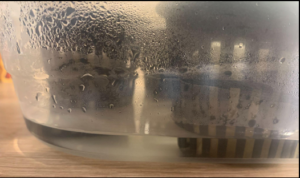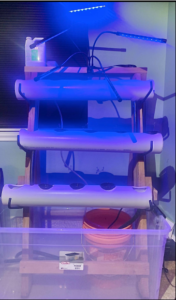By Emily Hester
The population of the world in 2050 is predicted to be about 10 billion people. Along with a population as big as 10 billion people comes many problems and risks, the economic rate at which we produce our food as of the current time, is about 9.3 billion tons, those rates need to be increased by 60 percent to sustain the world’s future population. Many varieties of scientists are investigating this problem striving to meet the needs of future generations. As a sophomore at Douglas County High School, I was eager to learn more about what I can do to understand this problem and explore possible solutions. My research led me to hydroponic systems, a system where plants are grown without soil and instead, placed inside of net cups, these cups are placed inside of holes in the PVC pipe which allows the water to flow through the system. The seed is held in place by rock wool which acts as a sponge to absorb nutrients and water which flows beneath the plant roots. A water pump pushes the water which is filled with the necessary nutrients for the plants to thrive. The system also has LED lights in place giving the plants the nutrients they need from the sun. At the end of my research, I created my own hydroponic system. By spending around $80 – $100 I saved a couple hundred dollars by building my own system. I created this hydroponic system over the span of about 3 months, by first making a wooden frame and installing PVC pipe with holes drilled for the net cups to be placed in. I then connected the rows of PVC pipe with tubing and connected the tubing to a water pump in a water bucket. I added nutrients to the water every week to keep the pH at appropriate levels. During the process of making the system itself, I germinate the seeds for 1-2 weeks to get the plants at a good starting point to grow. Germination happens by placing the seeds in the rockwool and in a closed moist container and then placed in a dark warm space (germination conditions vary depending on the type of plant being grown).
List of Supplies Used:
● Wood (including all construction materials, screws, etc.)
● PVC pipe (electric saw for cutting, and caps for end of pipe)
● Tubing
● Silicone caulking
● Ph water tester
● Liquid plant nutrients
● LED lights
● Water pump
● Water bucket
● Opt. water bucket (around the system for leaks)
● Net cups
● Rockwool
● Seeds
● Germination container
Hydroponic systems are efficient ways to grow large amounts of fruits and vegetables, they are highly controlled and allow plants to grow faster. These systems control the amount of water distributed to the plants being grown, by doing this it controls the temperature, pH balance, and nutrients. Nutrient solutions vary depending on the plant being grown. Growing plants in a garden is inducive of negative risk factors affecting their growth which is why hydroponics are more efficient and reliable. The amount of water needed in a system is 10% – 16% less than the amount of water needed to grow the same volume of crops on a farm, which conserves water. Light holds many of the nutrients for plants to grow efficiently and therefore is a huge part of growing successful plants. LED lights are suggested over natural sunlight because sunlight is not always consistent. LED (Light-Emitting Diodes) lights have been proven to be a viable source of light for plants. Fertilizers are necessary just as they are necessary in regular gardens, they are suggested because of the many nutrients they provide to help the plants grow healthy. After this research, I believe that hydroponic systems will be the best solution to sustain a substantial population increase, because they grow plants quicker and are able to be used at all times of the year and are reliable and consistent. A company that inspires me as a student is established in Sedalia, Colorado- they create hydroponic systems inside of old cargo shipping containers. They not only make a profit off of these but help many people all over the world and in our community become sustainable in growing food. For more information on Farm Box Foods visit http://farmboxfoods.com.



